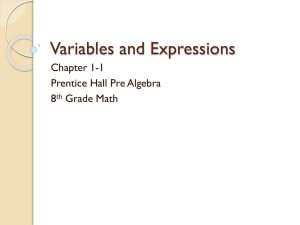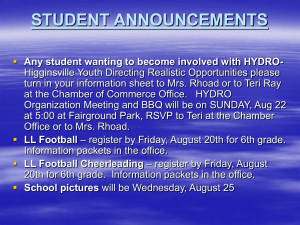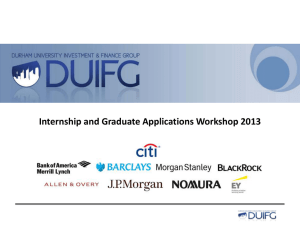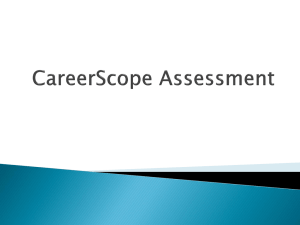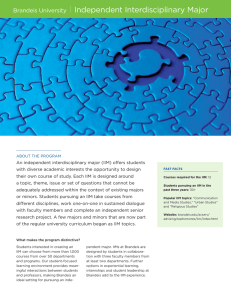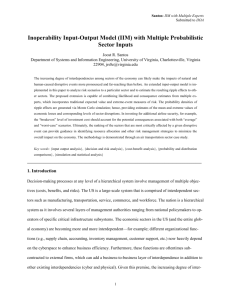Slides
advertisement
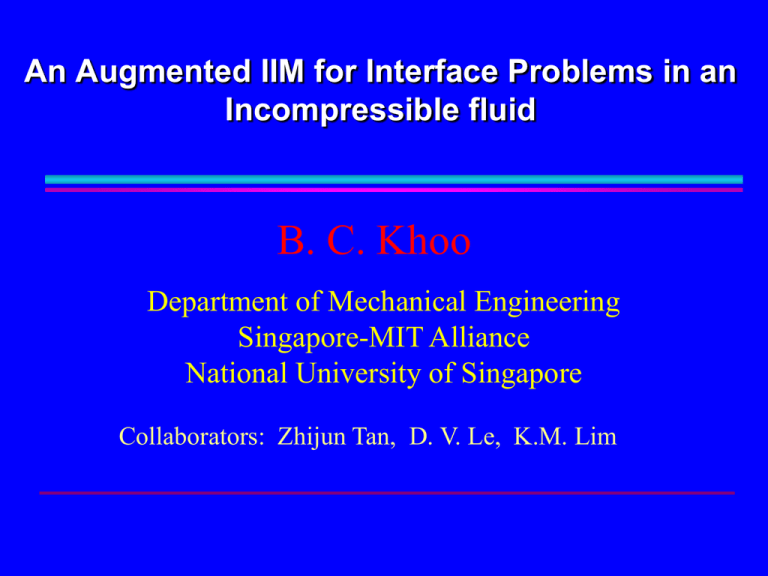
An Augmented IIM for Interface Problems in an
Incompressible fluid
B. C. Khoo
Department of Mechanical Engineering
Singapore-MIT Alliance
National University of Singapore
Collaborators: Zhijun Tan, D. V. Le, K.M. Lim
Outline
Introduction
IIM for simulation of incompressible two-fluid
interface
• Jump Conditions across the Interface
• Numerical Algorithm
• Numerical Results
IIM for the dynamics of inextensible interfaces
• Numerical Algorithm
• Numerical Results
Conclusions
Introduction
Peskin’s Immersed Boundary Method (IBM)
• Fluid dynamics of blood flow in human heart
• Biological flows: platelet aggregation, bacterial organisms
• Rigid boundaries
Immersed Interface Method (IIM by LeVeque and Li)
•
•
•
•
Elliptic equations, PDEs
Stokes flows with elastic boundaries
Navier-Stokes equations with flexible boundaries
Streamfunction-vorticity equations on irregular domains
Peskin’s Immersed Boundary Method
• Use a discrete delta function to spread the force density to nearby
Cartesian grid points.
N
F ( x, t ) f k (t ) Dh x X k (t ) s
k 1
Dh x h ( x)h ( y)
1
r
1
cos
, r 2h
h ( r ) 4h
2h
0,
otherwise
Ω+
X(s,t)
s
ΩΓ(t)
δΩ
• Smearing out sharp interface of O(h).
• First-order accurate for problems with non-smooth solutions.
Immersed Interface Method
• Incorporate the jumps in the solutions and their
derivatives into the finite difference scheme near the
interface
vi 1 vi 1
vx xi
C{vx }i
2h
C{vx }i C [v],[vx ],[vxx ],
• Avoid smearing out sharp interface
• Maintain second-order accuracy
(I) Navier-Stokes flows with discontinuous viscosity
• Incompressible Navier-Stokes Equations
• The interface exerts singular force on the fluid
n
s
• The motion of the moving interface satisfies
x
y
X
Coupled Jump Conditions
Decoupled Jump Conditions
Numerical Algorithm: Projection Method
A pressure-increment projection algorithm is employed
on a MAC staggered grid
k 1
vi , j 1
k u
i 1, j
ui , j
pi , j
vi , j
pi 1, j
k 1
u-mesh point
v -mesh point
p -mesh point
control point
No need for pressure boundary conditions dealing with p
Projection Method: 3 steps
Correction terms in the projection method
Determination of q at control points
Matrix-vector multiplication
Interface Evolution: Moving Interface
Moving Interface: Implementation
Numerical Results: Exact solution
Numerical Results: Rotational Flow
• Ω = [-1, 1]×[-1, 1]
• Interface: circle r = 0.5,
located at (0, 0)
• Force strength: f 0, f 0.1
1
2
• Viscosities: 0.01, 0.1
Numerical Results: Rotational Flow
Numerical Results: Elastic Membrane
• Ω = [-1.5, 1.5]×[-1.5, 1.5]
• Semi-major axis: 0.75;
semi-minor axis: 0.5
• Unstretched state: 0.5
• Elastic force:
f ( s, t ) T ( s, t ) τ ( s, t )
s
X
T ( s, t ) T0
1
s
0
Velocity and Pressure ( 0.01, 0.1 )
Evolutions of semi-major and semi-minor axises ( fixed)
Volume Conservation
0.1
0.1, 0.01
Iterations in BFGS and GMRES
(II) Inextensible interface in Stoks Flows
• Incompressible Stokes Equations
n
• The interface exerts singular force on the fluid
s
• The motion of the moving interface satisfies
y
x
X
Interface constraint and singular force
• The inextensibility constraint for an
evolving interface:
• The force strength f exerted on the fluid:
• An equivalent form:
Schematic illustration of a
2D interface in shear flow
Finite difference MAC scheme with correction terms
(#)
(#) Solved by FFT, Multigrid, PCG, etc
Determination of q at control points
Assuming that the tension q at the interface is known
The velocity at the control points
The surface divergenc at the control points:
The surface divergence of the velocity at the interface can be written as
Matrix-vector multiplication
(*)
Evolving Inextensible Interface: Implementation
Numerical Results: initially elliptical interface
• Ω = [-3, 3]×[-1.5, 1.5]
• Semi-major axis: 0.75;
semi-minor axis: 0.5
• Initial orientation angle: 0
Streamline pattern at steady state
Pressure profile at steady state
Shapes of deformed interface at different times
Initial (left) and final (right) shape of interface with different initial incidences.
Temporal evolution of orientation angle of interfaces with different initial incidences
Area conservation and arc length conservation
Numerical Results: initially concave interface
Initial orientation angle
0
Shapes of deformed interface at different times
Conclusions
A second order accurate IIM for solving viscous
incompressible flows with discontinuous viscosity is
presented.
An IIM is developed to simulate the dynamics of
inextensible interface in a viscous fluid.
Extend our IIM code to 3D problems.

